IAQ IQ, Summer 2017
©2017, Jeffrey C. May
Indoor air quality (IAQ) problems occur inside a building for a number of reasons that include the presence of mold as well as a food chain, with mites at the bottom and spiders at the top (all these living organisms produce allergenic fecal matter). Microbial growth (mold, yeast, bacteria), as well as a host of creatures, including mites, carpet beetles and other spider prey, require moisture for growth. As an IAQ professional, therefore, I am always concerned about moisture problems in buildings.
I used to be a home inspector: training and experience which have been vital to me in my IAQ work. I always start my IAQ inspections the way I used to start my home inspections: with a thorough look at the exterior.
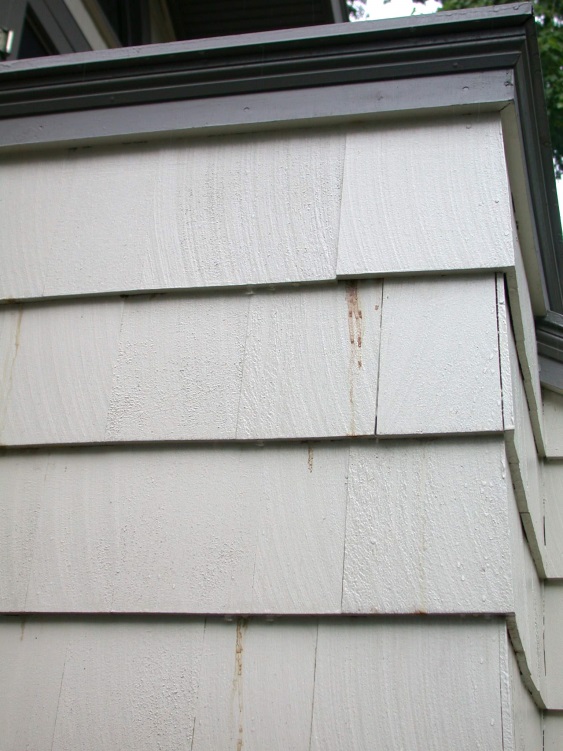
When I see signs of roof-water splash, improper grading, malfunctioning gutter systems, cedar-extract staining, and improperly sloped flashings, I worry before I even enter the building.
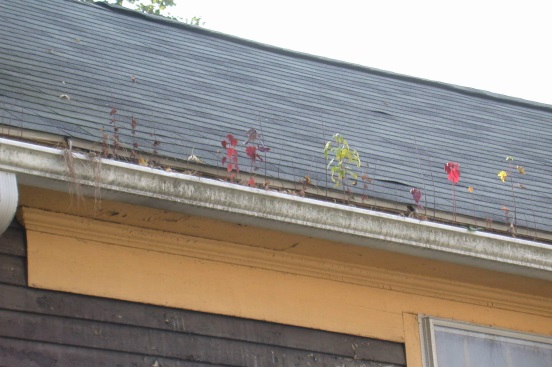
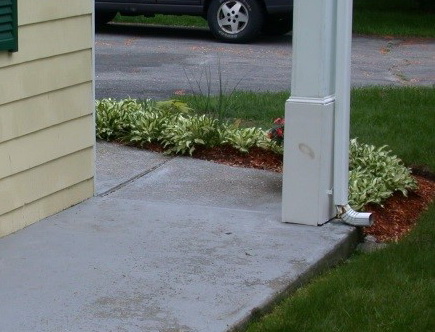
In the photograph above, the elbow joint is reversed and leaked. The pitch at the concrete slab was also reversed, and roof water soaked into the wood structure. There was extensive termite damage present.
Paint failure is an obvious sign of a moisture problem.
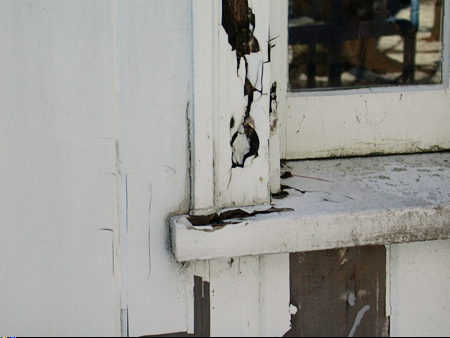
Leakage from the Exterior
In my opinion, the source of most moisture in exterior cladding is leakage from the exterior: inappropriate or missing flashings, cracks in joints or wood, lack of caulking, improper construction details, and wind-driven rain. This moisture enters cladding by means of simple, physical forces: gravity, air pressure differentials, and surface tension (capillarity).
Capillary action (sometimes capillarity, capillary motion, or wicking) is the ability of a liquid to flow into narrow spaces without the assistance of, or even in opposition to, external forces like gravity. Surface tension is the tension of the surface film of a liquid caused by the attraction of the particles to each other, as well as to the bulk of the liquid below the surface. Surface tension tends to minimize the surface area of a drop.
As dry wood is exposed to wetting or even to high humidity, the moisture content of the wood rises and the wood swells.
Young, Thin Paint Films
A young film has the capacity to expand with the wood, and the paint continues to adhere to the surface. A thin layer of paint is also more permeable to the passage of water than are multiple layers of paint in an older, thick film.
When moisture accumulates behind the paint film faster than it can diffuse out through the film, an actual blister of water can form in young, flexible paint films.
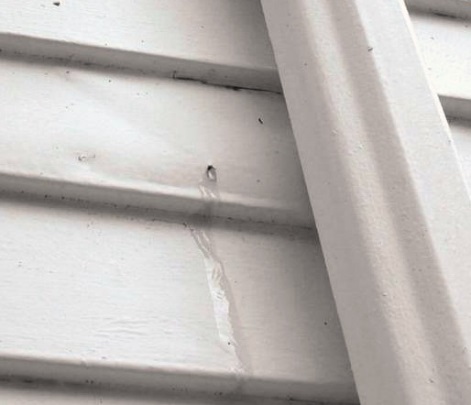
Thicker, Older Paint Films
Old films may lose their bonding from the substrate.
In a thick paint layer (over 15 mil), significant expansion in the wood is more likely to cause the paint film to crack. The severest cracking is usually perpendicular to the wood grain and direction of the brush strokes, because stress forces are built into the film due to the viscous flow of the paint film under the brush when the paint was first applied.
Chips of thick paint that have peeled to the substrate may have adhering wood fibers on the substrate side, suggesting good bonding with the wood. Cross-grain cracks (due to paint film shrinkage/wood expansion) can actually extend through the adhering wood fibers.
A single occurrence of ice damming can cause clapboards swelling sufficient to result in severe failure in a thick, old paint film.

Paint films also swell when wet. The thicker a film is, the less uniform the swelling.
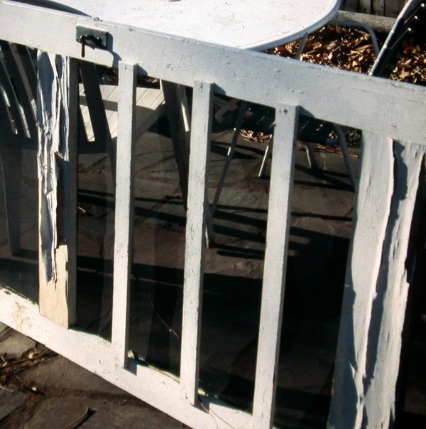
The screen door above from a covered Victorian porch was one hundred years old and had been painted dozens of times but never exposed to rain. To refinish the front door, I removed the screen door and stored it outside in the yard. It was rained on once and much of the paint peeled off.
Where is Moisture Absorbed?
When water flows across the outer paint surface, the exposed film absorbs moisture at the exterior plane, causing expansive dimensional change.
Due to flashing or other leakage into the cladding (or sometimes even the diffusion of interior moisture into the back of the paint film), a paint film can be exposed to higher moisture at the substrate side, and swell there first.
Cupping and Bending
In a thin film, the swelling of the paint layer may not give rise to significant differential forces, but in a thick film, as the wetted plane swells, it creates a cupping/bending force in the film. The layer can bend away from or toward the substrate, depending on which plane is swelling faster.
Similar forces can arise if different paint types in different layers within the paint film swell with moisture to varying extents. (This type of bending is similar to what occurs in bimetallic strips when one metal expandsmore with heat than the other bonded metal.)
The “curling/cupping” forces of the paint film may exceed the bonding strength of the film to the wood, and the film will fail. Water running down the face of painted clapboards causes this type of failure.
A moisture-saturated paint film exposed to the sun will dry at the surface more quickly than at the deeper planes. The resulting differences in moisture content can also give rise to cupping as well as forces that eventually tend to pull the paint film away from the substrate. Exposure of a thick, dry paint film to the sun can also give rise to cupping forces, due to temperature differentials between surfaces, causing the heated surface to expand faster than the unheated one.
Preventing Paint Failures
- All wood intended for exterior use should be painted on all sides. End-grain should be primed and sealed before installation.
- Window- and door-cap flashings should shed water to the front and not to the sides, where water is certain to enter wall gaps.
- Cap flashings should be single-pieces whenever possible, but caulked at joints if pieced.
- Small dabs of caulk can be applied to cap flashings as “end dams.”
- As we all know, roof and gutter water should never be allowed to run down the side of a building.
- A gutter system should direct water away from the foundation wall. If the water empties next to the foundation wall, there is a good chance that you will find signs of water intrusion below-grade.
- Weather-resistant species rather than ordinary pine should be used (though borate treatment of pine can retard decay).


Cement-Board Siding
One of my pet peeves has to do with the installation of cement-board siding: a composite of concrete and cellulose (wood fibers), built in several layers. This siding is heavy but porous.
I once put a piece of cement-board siding in water, and in ten minutes, the piece had absorbed 30% of its weight in water.
In one installation of this kind of siding, kick-out flashings were missing, so water from roof edges streamed down the cladding. As a result, the factory-applied paint failed under the roof drip edge in patterns following the water flow. The cement board was also damaged.

Another problem with this particular installation was that the angle-cut ends of the planks at the dormers on the gable roof were almost in contact with the roof shingles. These cut ends absorbed water, and all the paint peeled from the cement boards at the bottoms of the dormer walls. (The installation manuals now require a two-inch rather than a one-inch clearance to roof shingles.)
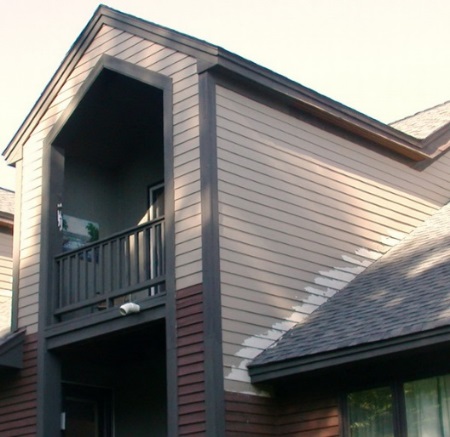
Paint was also peeling off the siding close to grade, where there was roof-water splash. Where the building faced wind-driven rain, water got behind the siding at all the butt joints.
How can such problems be avoided? Well, the obvious answer is that cement-board siding cannot get wet – ridiculous though that sounds.
Roof water should never flow down the siding, but this is a particularly worrisome condition with this kind of cladding.
There must be kick-out flashings at roof edges that intersect with vertical walls. It would also help if manufacturers of this type of siding always back-primed the boards and sealed the butt ends and end grains. Finally, I recommend that factory-supplied sealants be applied to all cut ends, which will reduce water absorption.
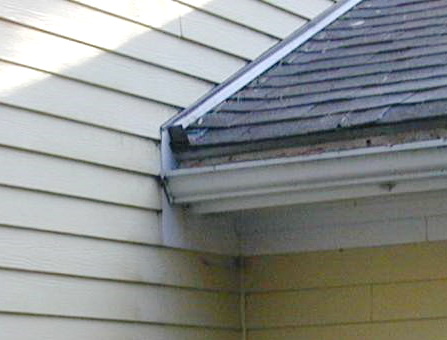
There is one more visual problem that can occur with installation of this kind of siding. Wherever the planks have been cut with a circular saw, the very fine dust that is produced adheres to the surface, giving the siding a flat, mottled look. Unfortunately, the only thing that seems to remove this dust is vinegar: a time-consuming chore! The cement boards should really be cut with shears made for this purpose, rather than sawed with a circular blade.
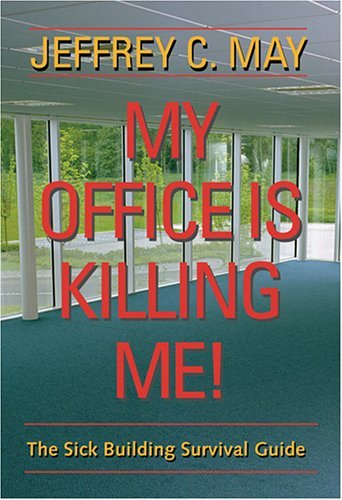
We offer phone consultations for a fee, but we are always happy to speak with home-inspection clients free of charge if we can give them any advice regarding their IAQ concerns, including building odors and mold. I also try to fit your clients into my schedule if they tell me you referred them to me. Lastly, I am happy to give you guidance if you are threatened with legal action over indoor air quality issues, but in the end, I hope to never hear from you on that score!!
Much of my work is in residential buildings, but I also do IAQ inspections in offices, schools and hospitals. If any of your clients are worried about environmental issues in their places of work, please refer them to my book below, available on amazon.com.
